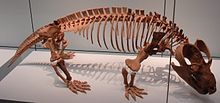Probainognathia
Appearance
| Probainognathia Temporal range:
| |
|---|---|

| |
| Fossil of the probainognathian Chiniquodon theotonicus in the Staatliches Museum für Naturkunde Stuttgart | |
| Scientific classification | |
| Domain: | Eukaryota |
| Kingdom: | Animalia |
| Phylum: | Chordata |
| Clade: | Synapsida |
| Clade: | Therapsida |
| Clade: | Cynodontia |
| Clade: | Eucynodontia |
| Clade: | Probainognathia |
| Subgroups | |
The probainognathians are members of one of the two major clades of the infraorder Eucynodontia, the other being Cynognathians. The earliest forms were carnivorous and insectivorous, though some species eventually also evolved herbivorous diets. The earliest and most basal probainognathian is Lumkuia, from South Africa. Three groups survived the extinction at the end of Triassic: the Tritheledontidae and Tritylodontidae, who both survived until the Jurassic—the latter possibly even into the Cretaceous (Xenocretosuchus)—and Mammaliaformes, who gave rise to the mammals.[1]
Classification
Taxonomy

- Suborder Cynodontia
- Infraorder Eucynodontia
- (unranked) Probainognathia
- Family Ecteniniidae
- Family Lumkuiidae
- Superfamily Chiniquodontoidea
- Family Chiniquodontidae
- Family Tritheledontidae
- Family Probainognathidae
- (unranked) Prozostrodontia
- Prozostrodon
- Family Brasilodontidae
- Family Dromatheriidae
- Family Therioherpetidae
- Family Tritylodontidae
- (unranked) Mammaliaformes
- Class Mammalia
- (unranked) Probainognathia
- Infraorder Eucynodontia
Phylogeny
Below is a cladogram from Ruta, Botha-Brink, Mitchell and Benton (2013) showing one hypothesis of cynodont relationships:[2]
| Cynodontia; |
| ||||||||||||||||||||||||||||||||||||||||||||||||||||||||||||
See also
References
- ^ The slow and fast steps to becoming a mammal
- ^ Ruta, M.; Botha-Brink, J.; Mitchell, S. A.; Benton, M. J. (2013). "The radiation of cynodonts and the ground plan of mammalian morphological diversity". Proceedings of the Royal Society B: Biological Sciences. 280 (1769): 20131865. doi:10.1098/rspb.2013.1865. PMC 3768321. PMID 23986112.






